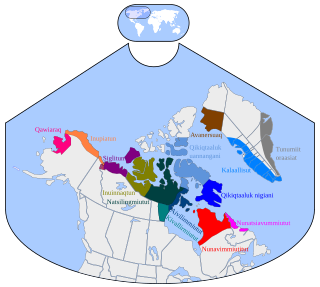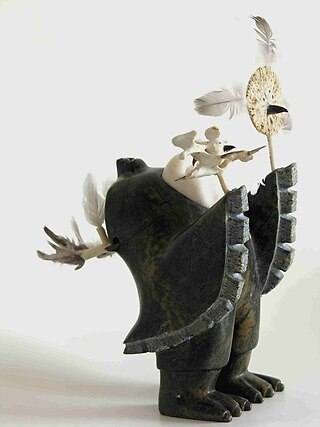Related Research Articles

Inuit throat singing, or katajjaq, is a distinct type of throat singing uniquely found among the Inuit. It is a form of musical performance, traditionally consisting of two women who sing duets in a close face-to-face formation with no instrumental accompaniment, in an entertaining contest to see who can outlast the other; however, one of the genre's most famous practitioners, Tanya Tagaq, performs as a solo artist. Several groups, including Tudjaat, The Jerry Cans, Quantum Tangle and Silla + Rise, also now blend traditional throat singing with mainstream musical genres such as pop, folk, rock and dance music.

Nunavik comprises the northern third of the province of Quebec, part of the Nord-du-Québec region and nearly coterminous with Kativik. Covering a land area of 443,684.71 km2 (171,307.62 sq mi) north of the 55th parallel, it is the homeland of the Inuit of Quebec and part of the wider Inuit Nunangat. Almost all of the 14,045 inhabitants of the region, of whom 90% are Inuit, live in fourteen northern villages on the coast of Nunavik and in the Cree reserved land (TC) of Whapmagoostui, near the northern village of Kuujjuarapik.

Inuktitut, also known as Eastern Canadian Inuktitut, is one of the principal Inuit languages of Canada. It is spoken in all areas north of the tree line, including parts of the provinces of Newfoundland and Labrador, Quebec, to some extent in northeastern Manitoba as well as the Northwest Territories and Nunavut. It is one of the aboriginal languages written with Canadian Aboriginal syllabics.

Kuujjuaq, formerly known as Fort Chimo and by other names, is a former Hudson's Bay Company outpost at the mouth of the Koksoak River on Ungava Bay that has become the largest northern village in the Nunavik region of Quebec, Canada. It is the administrative capital of the Kativik Regional Government. Its population was 2,668 as of the 2021 census.

Sheila Watt-Cloutier is a Canadian Inuk activist. She has been a political representative for Inuit at the regional, national and international levels, most recently as International Chair for the Inuit Circumpolar Council. Watt-Cloutier has worked on a range of social and environmental issues affecting Inuit, most recently, persistent organic pollutants and global warming. She has received numerous awards and honours for her work, and has been featured in a number of documentaries and profiled by journalists from all media. Watt-Cloutier sits as an adviser to Canada's Ecofiscal Commission. She is also a senior fellow at the Centre for International Governance Innovation.

Ivujivik is a northern village in Nunavik, Quebec, and the northernmost settlement in any Canadian province, although there are settlements further north in the territories. Its population in the 2021 Canadian census was 412. Unlike most other northern villages in Nunavik but like Puvirnituq, it has no Inuit reserved land of the same name associated with it.

Inuit art, also known as Eskimo art, refers to artwork produced by Inuit, that is, the people of the Arctic previously known as Eskimos, a term that is now often considered offensive. Historically, their preferred medium was walrus ivory, but since the establishment of southern markets for Inuit art in 1945, prints and figurative works carved in relatively soft stone such as soapstone, serpentinite, or argillite have also become popular.

Inuit are a group of culturally similar indigenous peoples inhabiting the Arctic and subarctic regions of Greenland, Labrador, Quebec, Nunavut, the Northwest Territories, and Alaska. Inuit languages are part of the Eskimo–Aleut languages, also known as Inuit-Yupik-Unangan, and also as Eskaleut. Inuit Sign Language is a critically endangered language isolate used in Nunavut.

Kangiqsujuaq is a northern village in Nunavik, Nord-du-Québec, Quebec, Canada. It had a population of 837 in the Canada 2021 Census. The community has also been known as Wakeham Bay. The name "Kangiqsujuaq" means "the large bay" in Inuktitut.
Taamusi Qumaq, was an Inuit historian, linguist, writer, politician and elder from Nunavik, Québec, Canada who contributed to the preservation of the Inuit language and traditional culture. Despite lacking any formal schooling, Qumaq published two seminal works on the Inuit culture: a 30,000-word comprehensive Inuktitut dictionary and an encyclopedia on Inuit traditional customs and knowledge. He was fluent in Inuktitut only.
Donat Savoie is a Canadian anthropologist, was the interim Executive Director of Canada's Inuit Relations Secretariat and chief federal negotiator for Nunavik self-government before his retirement in 2006.
Mitiarjuk Attasie Nappaaluk (1931–2007) was a Canadian Inuk writer. She was most noted for Sanaaq, one of the first Inuktitut language novels; although written earlier, it was published later than Markoosie Patsauq's Harpoon of the Hunter.
Melissa Haney is an Inuk pilot from Quebec, Canada. She is noted for being the first female Inuk pilot with Air Inuit to reach the rank of captain. In 2017, the Canadian Ninety-Nines released a postage stamp in commemoration of her achievements.
Isa Paddy Aqiattusuk (1898–1954) was an Inuit artist.
Lucy Meeko (1929-2004) was an Inuit artist known for her multidisciplinary work in sculpture, printmaking, basketry and sewing. Meeko was born in Kuujjuaraapik, Quebec. Her career as a sculptor began in the 1950s; in the 1970s, together with her husband Noah, she created engravings for the Kuujjuarapic Cooperative.
Asinnajaq, a.k.a.Isabella Rose Rowan-Weetaluktuk, is a Canadian Inuk visual artist, writer, filmmaker, and curator, from Inukjuak, Quebec. She is most noted for her 2017 film Three Thousand, which received a Canadian Screen Award nomination for Best Short Documentary Film at the 6th Canadian Screen Awards.
Akitiq Sanguya (1935) is an Inuit sculptor from Clyde River/Kangiqtugaapik.
Adamie Niviaxie (1925–?) was an Inuk sculptor.
Zebedee Nungak is a Canadian Inuit author, actor, essayist, journalist, and politician. As a child, Nungak was taken from his home in the community of Saputiligait, along with two other children, for the purposes of an experiment by the Canadian government to "[expunge] them of Inuit culture and groom them to become northern leaders with a southern way of thinking." Nungak later became pivotal in securing successful land rights claims and the creation of his home territory of Nunavik.
References
- ↑ "Avataq Cultural Institute". Archived from the original on 2018-09-09. Retrieved 2019-05-19.
- 1 2 Stern, Pamela R. (2013-09-26). Historical Dictionary of the Inuit. ISBN 9780810879126.
- 1 2 "AVATAQ Cultural Institute". 2013-06-23.
- ↑ Crandall, Richard C.; Crandall, Susan M. (2015-07-25). An Annotated Bibliography of Inuit Art. ISBN 9781476607436.
- ↑ Issenman, Betty Kobayashi (2011-11-01). Sinews of Survival: The Living Legacy of Inuit Clothing. ISBN 9780774841894.
- ↑ "Avataq Cultural Institute". Archived from the original on 2015-10-01. Retrieved 2019-05-19.
- ↑ "Avataq opens new offices, signs deal with Quebec". Nunatsiaq News (nunatsiaq.com). 13 December 2011.
- ↑ Pelto, Pertti J. (2016-06-16). Applied Ethnography: Guidelines for Field Research. ISBN 9781315434681.
- ↑ "Marburger geographische Schriften" [Marburg geographical writings]. 1981 – via books.google.com.
- ↑ "Excavated Inuit bones returned to Avataq Culture Institute". www.thedartmouth.com. Archived from the original on 2019-01-18. Retrieved 2019-05-19.
- ↑ "Nunavik bones to be laid to rest". nunatsiaq.com. 2018-07-19.
- ↑ "Decolonizing Inuit Art". the McGill Daily. Archived from the original on 2019-03-22. Retrieved 2019-05-19.